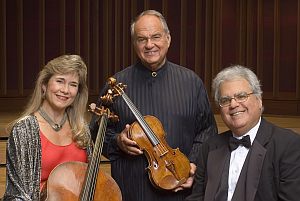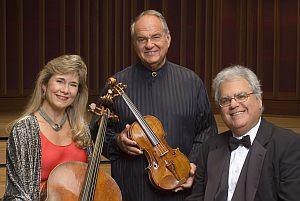
The Kalichstein-Laredo-Robinson Trio opened its Sunday concert at Herbst Theatre with a bit of whimsy: a short piece by Beethoven, without opus number, that was never intended to be published or, indeed, played in public. An Allegretto, it was composed around 1812 in sonata form but lacks the succeeding movements that would make it into a complete work for piano trio. A trifle, compared to the great “Archduke” Trio, composed the previous year, it was, as Kalichstein told us in his prefatory remarks, written for the talented 9-year-old daughter of Antonie Brentano.
Thanks to the research of Maynard Solomon, Antonie is now believed to be the intended recipient of the letter to “The Immortal Beloved.” Both mother and daughter would receive many marvelous works a decade later: Maximilien, the daughter, was the dedicatee of the Sonata Op. 109, while her mother’s name was placed atop Beethoven’s final masterpiece, the “Diabelli” Variations.
The KLR Trio played the Allegretto with a touching restraint that made me imagine the youngster as she played the piece from the manuscript with her parents, perhaps saying, “Uncle Ludwig surely means well, but this is hard to read. Mama, could you ask him to write more neatly?”
The effect of beginning a concert with one of Beethoven’s least-public works could not have been more disarming; it also was the perfect foil for what followed. The Shostakovich Trio in E Minor (1944) also contained the voices of children. Yet here they are frightened and pleading for their lives in the midst of war. Shostakovich documented the siege of Leningrad in his symphonic works, but in a chamber music piece listeners may feel the daily effects of war more poignantly: the suffering of individuals as they experienced both the chaos and the eerie calm of waiting for the next, possibly ultimate, moment of their existence. The KLR Trio played out these feelings in a supremely evocative performance.
While it’s clear that Shostakovich was powerfully influenced by Mahler, he left in some moments that verge on parody of him, as in the demented klezmer music of the Scherzo. The slow movement is an elegy built largely on the “farewell” figure, a turn that opens the final movement of Mahler’s Ninth Symphony. That work, composed in the years leading up to World War I, turned out to be Mahler’s last good-bye, both to life and to so much more: the sense of a civilized world where art, Ninth Symphonies, and Odes to Joy held our greatest hope for humanity. The final cadence of the Shostakovich trio, with strummed E-major chords in the strings, just barely held out hope that the world might survive.
Spot-on Grandeur, but Humor Absent
The second half of the program contained a single work, Beethoven’s largest trio, in B flat, Op. 97, which was dedicated to Archduke Rudolph; it felt like a return to life. The same qualities that I enjoyed on the first half of the program were all there. The sounds that each player drew from their instrument were even more beautiful in the Beethoven, and breathed great conviction and authority. This sufficed for the broad theme of the opening, but then something crucial seemed lacking.
Perhaps it’s the grandeur of the noble nickname of the piece, “The Archduke,” that leads performers, even terrific ones like the KLR Trio, to miss a crucial element of the piece: its humor. Right from the get-go, the second theme of the first movement comes in the key a step too high, surely the first clue that Beethoven was putting us on our mettle. The Scherzo is also full of all manner of high jinks, including an uproarious waltz erupting in the piano in the midst of a rather too long and gloomy trio section.
My main beef with the performance of the latter work was the lugubrious tempo of much of the slow movement. Beethoven marks it Andante cantabile, but “with motion,” and Kalichstein observed this in his playing of the first part of the theme. Then when the strings came in and the piano took on a more accompanying role, the tempo slackened to a profound Adagio — full of noble sentiment, to be sure, though missing the animation that would have better set the stage for the delightful finale: a rollicking dance number that seems to have all the time in the world.
Yet here, too, the KLR Trio got everything but the wit of the piece. The Presto coda is the scene of another of Beethoven’s jokes: It’s a most un-Germanic tarantella in 12/8 time. It starts quite softly in A major, though a step too low, and after a page of heavenly dancing (the lightest in all his music) there’s a sudden fortissimo and then the piano, which has been patiently playing the world’s longest trill, firmly guides the music back into the proper key. Power play? I think not. Beethoven was only aiming to please.

